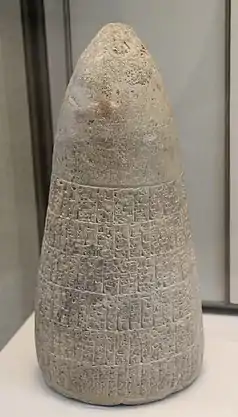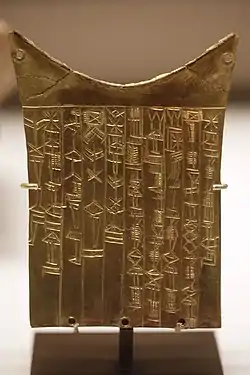Enakalle
Enakalle (Sumerian: 𒂗𒀉𒆗𒇷, EN.A.KAL-le), or Enakalli, was the king of Umma circa 2500–2400 BC, a Sumerian city-state, during the Early Dynastic III period (2600–2350 BC).
| Enakalle 𒂍𒀭𒁕𒊬 | |
|---|---|
| King of Umma | |
.jpg.webp) Stone tablet for the dedication of a temple, inscribed by Il, king of Umma, c. 2400 BC, and mentioning his father Eandamu (𒂍𒀭𒁕𒊬), and his grandfather King Enakalle. Oriental Institute Museum, University of Chicago | |
| Reign | c. 2500 BC – 2400 BC |
| Predecessor | Ush |
| Successor | Ur-Lumma (son) |
| Dynasty | 1st Dynasty of Umma |
Enakalle in the cone of Entemena
His predecessor Ush, ruler of Umma, attacked nearby Lagash after ripping out the stele of Mesilim, trying to take Gu-Edin, as recording in the Cone of Entemena.[1][2] Ush was severely defeated by Eannatum of Lagash, in a battle recorded in the Stele of the Vultures, losing 3,600 men in battle, and being toppled and put to death by his own people in Lagash.[3]
Enakalle, his successor, finally made a peace treaty with Eannatum of Lagash, as described in the Cone of Entemena:[1][2][3]

𒂍𒀭𒈾𒁺 𒉺𒋼𒋛 𒉢𒁓𒆷𒆠 𒉺𒄑𒉋𒂵 𒂗𒋼𒈨𒈾 𒉺𒋼𒋛 𒉢𒁓𒆷𒆠𒅗𒆤
e2-an-na-tum2 ensi2 lagaški pa-bil3-ga en-mete-na ensi2 lagaški-ka-ke4
"Eannatum, ruler of Lagash, uncle of Entemena, ruler of Lagaš"
39–42
𒂗𒀉𒆗𒇷 𒉺𒋼𒋛 𒄑𒆵𒆠𒁕 𒆠 𒂊𒁕𒋩
en-a2-kal-le ensi2 ummaki-da ki e-da-sur
"fixed the border with Enakalle, ruler of Umma"
Enakalle in inscriptions
Ur-Lumma was the son of Enakalle, and his successor. He challenged Enannatum I, but was defeated by his successor Enmetena.[6][7]
.jpg.webp) Inscription with the name of Enakalle, and standard Sumero-Akkadian cuneiform.
Inscription with the name of Enakalle, and standard Sumero-Akkadian cuneiform.
 Votive plate of Queen Bara-irnum of Umma, "wife of Gishakidu, king of Umma, daughter of Ur-Lumma, king of Umma, grand-daughter of Enakalle, king of Umma, daughter-in-law of Il, king of Umma", to God Shara, in gratitude for sparing her life.[9][10]
Votive plate of Queen Bara-irnum of Umma, "wife of Gishakidu, king of Umma, daughter of Ur-Lumma, king of Umma, grand-daughter of Enakalle, king of Umma, daughter-in-law of Il, king of Umma", to God Shara, in gratitude for sparing her life.[9][10] "Enakalle" on the plate of queen Bara-irnun
"Enakalle" on the plate of queen Bara-irnun
References
- King 1994, pp. 126–128.
- King & Hall 2006, pp. 171–173.
- Sallaberger, Walther; Schrakamp, Ingo (2015). History & Philology (PDF). Walther Sallaberger & Ingo Schrakamp (eds), Brepols. pp. 74–76. ISBN 978-2-503-53494-7.
- "Cone of Enmetena, king of Lagash". 2020.
- "CDLI-Found Texts". cdli.ucla.edu. Retrieved 2018-03-12.
- Van De Mieroop, Marc (2004). A History of the Ancient Near East: Ca. 3000-323 BC. Wiley. pp. 50–51. ISBN 9780631225522.
- Sallaberger, Walther; Schrakamp, Ingo (2015). History & Philology (PDF). Walther Sallaberger & Ingo Schrakamp (eds), Brepols. pp. 74–80. ISBN 978-2-503-53494-7.
- "Louvre Museum Official Website". cartelen.louvre.fr.
- Art of the First Cities: The Third Millennium B.C. from the Mediterranean to the Indus. Metropolitan Museum of Art. 2003. p. 78. ISBN 978-1-58839-043-1.
- Thomas, Ariane; Potts, Timothy (2020). Mesopotamia: Civilization Begins. Getty Publications. p. 108. ISBN 978-1-60606-649-2.
Sources
- King, Leonard W. (1994) [1st published 1910 by Chatto and Windus]. A History of Sumer and Akkad. Ripol Classic. ISBN 978-5-87664-034-5.CS1 maint: ref=harv (link)
- King, L. W.; Hall, H. R. (1 February 2006) [1st published 1907]. Egypt and Western Asia in the Light of Recent Discoveries. Cosimo, Inc. ISBN 978-1-59605-763-0.CS1 maint: ref=harv (link)
